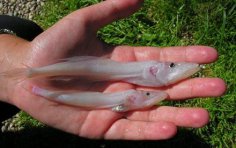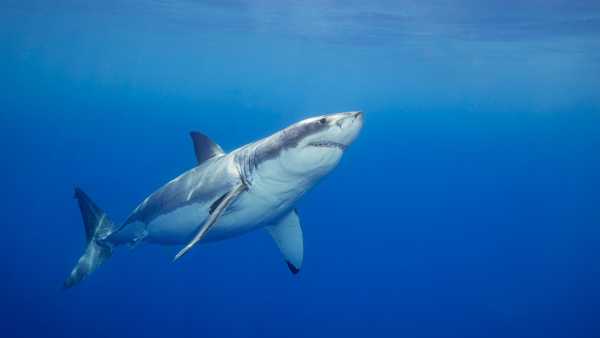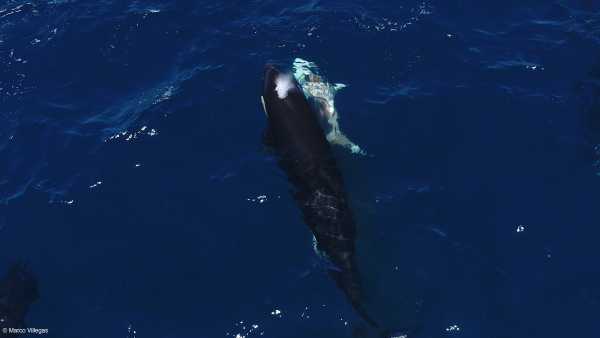
Lake Baikal is an amazing place. Wherever you look, you see plants and animals that live only in the lake or on its shores—so-called endemics. It's as if you've landed on an island, cut off from civilization. The fish I want to tell you about today is found only here and can't live anywhere else.
The fish's name is also unusual—golomyanka. There are no similar fish in the world. It has no swim bladder, no scales. Actually, fish without swim bladders are known, primarily deep-sea creatures, for whom the bladder not only doesn't need it, but is even harmful. Under the pressures found in the areas where these fish live, it can burst on its own, that's obvious. But there are no such freshwater fish; the depths aren't deep enough. Lake Baikal is the only place where deep-sea fish, including the golomyanka, can live. Everything about the golomyanka is remarkable: its body is 35% fat, it's viviparous, but what's truly astounding is that it can give birth to 2,000-3,000 fry in a single birth. That's how amazing this fish was born.
Its Russian name comes from the depths of time. It turns out there was a word in the 16th century called “golomya,” which meant a place remote from the shore of a river or lake. From this came “golomen,” meaning bottomless places, and the rest is obvious. Dahl's dictionary states it this way: “Golomyanka is a Baikal fish that always lives in the golomen, at great depths.”
Scientists subsequently proved that there are two types of golomyanka—large and small—that differ not only in physical size but also in several key aspects, leading to their classification as separate species. Some differences are so significant that even those unfamiliar with them can immediately distinguish one from the other. For example, an adult small golomyanka remains translucent, with its spine and blood vessels clearly visible through its skin, while a large golomyanka becomes whitish and opaque. This is believed to be due to the difference in fat content—in the large, it can reach up to 44% of its body weight.
Every night, the golomyanka travels from its deepest depths to the surface, where it appears to hover in a tilted position with its mouth wide open. With its quick reflexes, the golomyanka quickly pounces on passing food—crustaceans, its own fry, and anything else it can eat. After sunrise, the fish follows the food, which descends to depths of 50-100 meters, and then descends to greater depths where sunlight no longer penetrates.
Oilfish are solitary fish, not known for their schooling. Estimates place the lake's population at around 50 billion, representing at least 200,000 tons of biomass. While that might seem like a large number, their combined weight isn't all that significant. The problem is, the fish themselves are small: female oilfish are no more than 25 cm long, while males are 16 cm. Naturally, small oilfish are even smaller, although the size difference between males and females is roughly the same. It's also striking that oilfish have very few males compared to females. Consider this: among large oilfish, males account for only 3% of the total population, meaning “statistically, there are three males for every 97 females.” One wonders what would happen to humans under such circumstances. Small oilfish fare significantly better, but there are still only 20 males for every 80 females.
Large golomyanka females spawn between June and August, after which they die immediately. Small golomyanka spawn between February and April, after which the females also die, but in smaller numbers than the large ones.
It was the death of the females that first revealed the existence of this amazing fish. Typically, in November and December, numerous dead fish washed up on the shores. For a long time, no one saw live fish, until Polish naturalists Benedykt Dybowski and Wiktor Godleski, exiled there as participants in the 1830 uprising, managed to catch 12 live female golomyanka in an ice hole. It was then that it was discovered that the golomyanka is a viviparous fish, a real sensation, as previously it was believed that only the tropics could harbor viviparous fish, while in the north, fish must spawn.
Due to their high fat content, the fish floated to the surface after death and ended up on the shore. According to eyewitness accounts, the water washed up with huge numbers of dead fish, which was successfully exploited by local residents who collected golomyanka, rendered its fat, and sold it to merchants. These merchants, in turn, resold the fat to pharmacies, as doctors used it to treat many ailments, or exported it to China for use in traditional medicine. During wars fought by Russian soldiers, golomyanka fat was used to recuperate the wounded. In pre-revolutionary times, golomyanka harvesting and rendering were the work of artisans; no industrial production was established.
It's curious why no one finds mountains of these fish, or even a single specimen, on the shore these days. Where have they gone? After all, there haven't been any fewer of them in the lake. This is another mystery of the golomyanka.
This fish has never been caught commercially, but there are known cases of fishermen eating frozen or raw golomyankas caught in their nets, after lightly salting and peppering them. Fishing for golomyankas with conventional means is generally impossible, as they don't school and don't bite. So, a method for catching them was devised that was so ingenious that it was even recognized as an invention and patented. The method is truly unique and incredibly simple, and it was devised by the ichthyologist Mamontov. Golomyankas are caught using frayed ends of nylon rope, which they cling to with their teeth.
I wonder where these fish in Lake Baikal came from? Some scientists suggest they formed in the depths of Lake Baikal about two million years ago, but others believe Lake Baikal itself emerged no later than 150,000 years ago. If that's true, then the golomyanka is much younger. It's believed that golomyanka stopped laying eggs and began releasing hatched young into the water.
Modern research and observation tools have revealed that the golomyanka lives even at the very bottom of Lake Baikal, at depths of up to 1,620 meters, and makes multiple trips from bottom to top and back again. So, we look forward to uncovering more secrets of this amazing fish.





